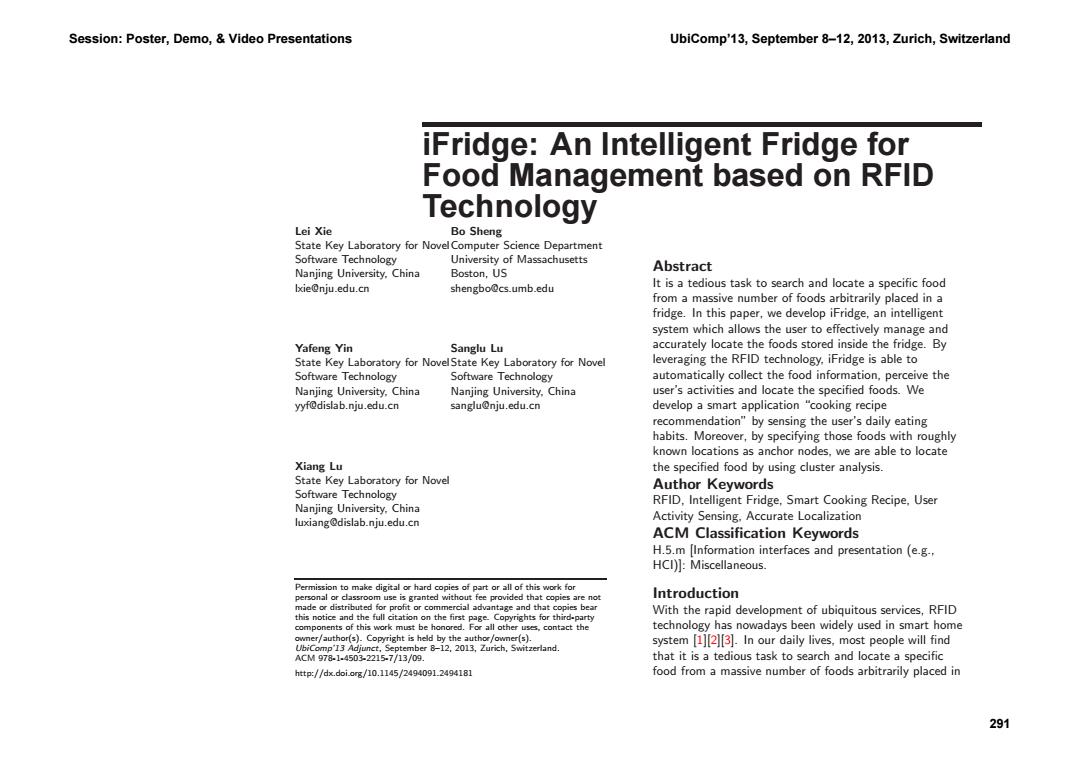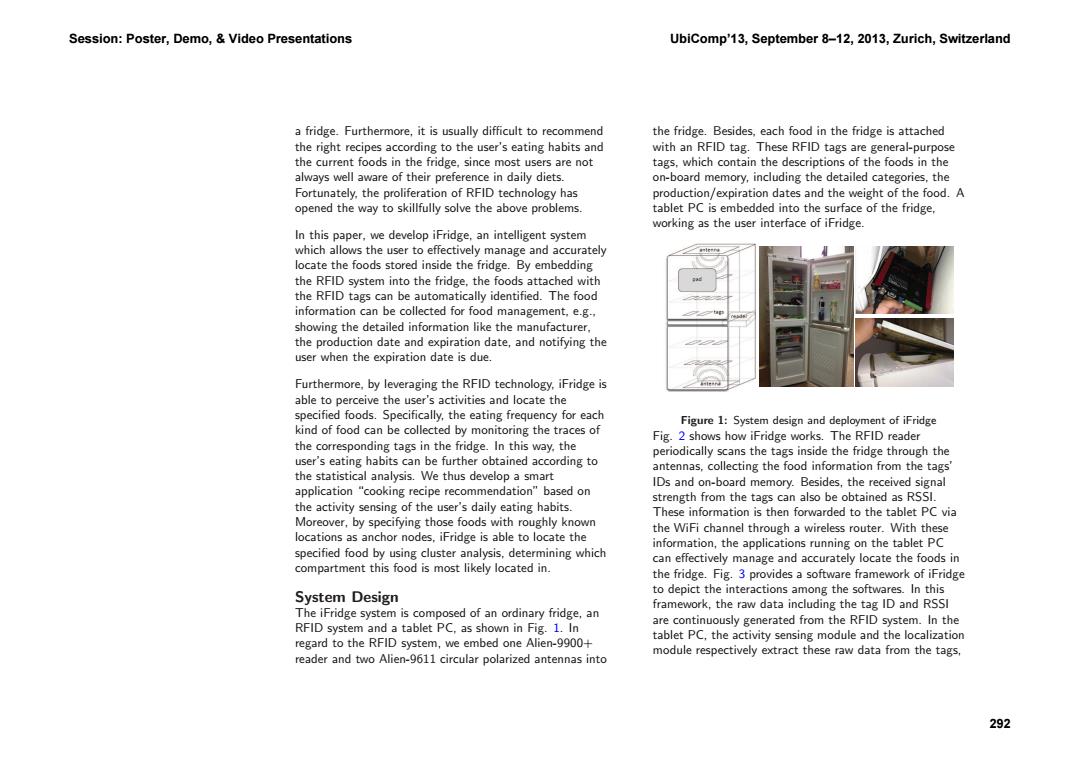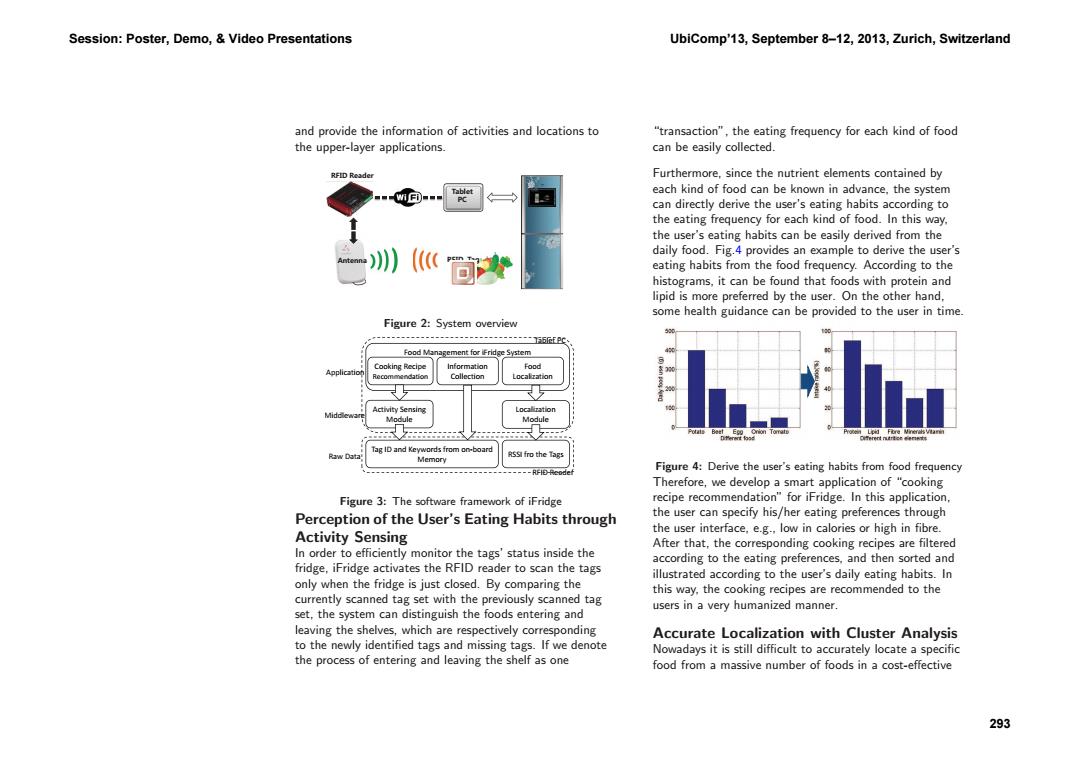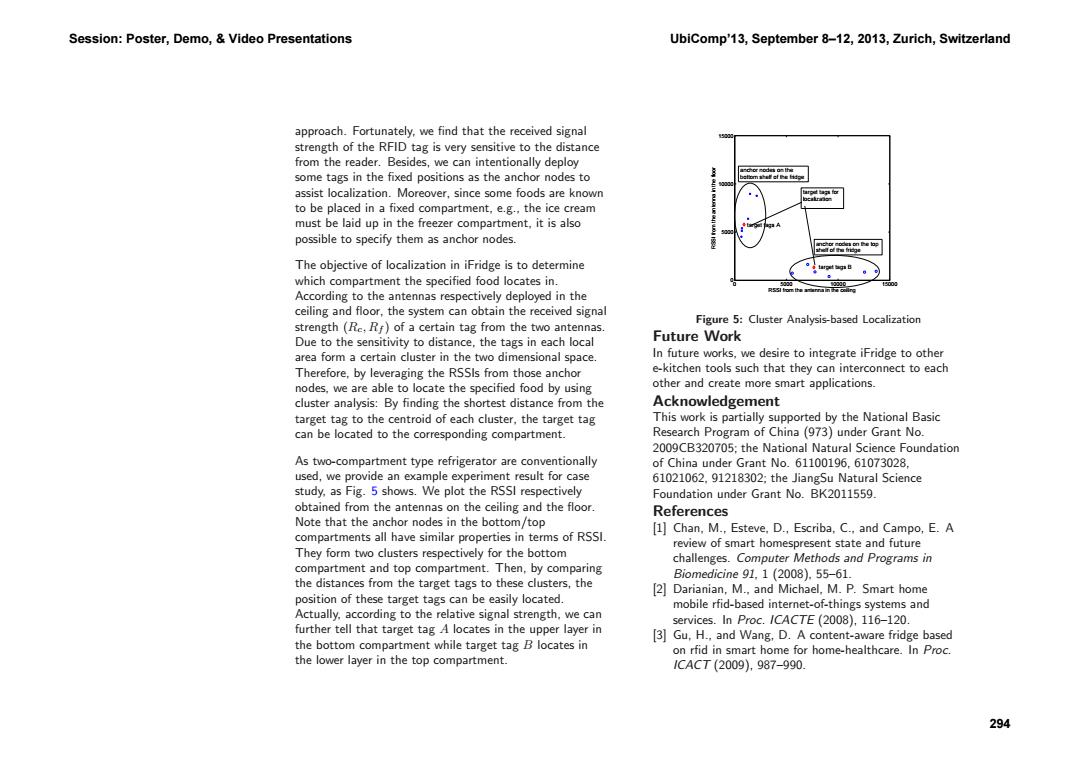
Session:Poster,Demo,Video Presentations UbiComp'13,September 8-12,2013,Zurich,Switzerland iFridge:An Intelligent Fridge for Food Management based on RFID Technology Lei Xie Bo Sheng State Key Laboratory for NovelComputer Science Department Software Technology University of Massachusetts Nanjing University.China Boston,US Abstract lxie@nju.edu.cn shengbo@cs.umb.edu It is a tedious task to search and locate a specific food from a massive number of foods arbitrarily placed in a fridge.In this paper,we develop iFridge,an intelligent system which allows the user to effectively manage and Yafeng Yin Sanglu Lu accurately locate the foods stored inside the fridge.By State Key Laboratory for NovelState Key Laboratory for Novel leveraging the RFID technology.iFridge is able to Software Technology Software Technology automatically collect the food information,perceive the Nanjing University.China Nanjing University,China user's activities and locate the specified foods.We yyf@dislab.nju.edu.cn sanglu@nju.edu.cn develop a smart application "cooking recipe recommendation"by sensing the user's daily eating habits.Moreover,by specifying those foods with roughly known locations as anchor nodes,we are able to locate Xiang Lu the specified food by using cluster analysis. State Key Laboratory for Novel Author Keywords Software Technology Nanjing University,China RFID,Intelligent Fridge,Smart Cooking Recipe,User luxiang@dislab.nju.edu.cn Activity Sensing.Accurate Localization ACM Classification Keywords H.5.m [Information interfaces and presentation (e.g., HCI)]:Miscellaneous. Permission to make digital or hard copies of part or all of this work for personal or classroom use is granted without fee provided that copies are not Introduction made or distributed for profit or commercial advantage and that copies bear this oticand the full citation on thefirst page Copyrights for thirdparty With the rapid development of ubiquitous services,RFID components of this work must be honored.For all other uses,contact the technology has nowadays been widely used in smart home owner/author(s).Copyright is held by the author/owner(s). ember 8-12,2013,Zurich,Switzerland system [1][2][3].In our daily lives,most people will find ACM978-1.4503-2215.7/13/09. that it is a tedious task to search and locate a specific htp://dx.doi.ag/10.1145/2494091.2494181 food from a massive number of foods arbitrarily placed in 291
iFridge: An Intelligent Fridge for Food Management based on RFID Technology Lei Xie State Key Laboratory for Novel Software Technology Nanjing University, China lxie@nju.edu.cn Bo Sheng Computer Science Department University of Massachusetts Boston, US shengbo@cs.umb.edu Yafeng Yin State Key Laboratory for Novel Software Technology Nanjing University, China yyf@dislab.nju.edu.cn Sanglu Lu State Key Laboratory for Novel Software Technology Nanjing University, China sanglu@nju.edu.cn Xiang Lu State Key Laboratory for Novel Software Technology Nanjing University, China luxiang@dislab.nju.edu.cn Permission to make digital or hard copies of part or all of this work for personal or classroom use is granted without fee provided that copies are not made or distributed for profit or commercial advantage and that copies bear this notice and the full citation on the first page. Copyrights for third-party components of this work must be honored. For all other uses, contact the owner/author(s). Copyright is held by the author/owner(s). UbiComp’13 Adjunct, September 8–12, 2013, Zurich, Switzerland. ACM 978-1-4503-2215-7/13/09. http://dx.doi.org/10.1145/2494091.2494181 Abstract It is a tedious task to search and locate a specific food from a massive number of foods arbitrarily placed in a fridge. In this paper, we develop iFridge, an intelligent system which allows the user to effectively manage and accurately locate the foods stored inside the fridge. By leveraging the RFID technology, iFridge is able to automatically collect the food information, perceive the user’s activities and locate the specified foods. We develop a smart application “cooking recipe recommendation” by sensing the user’s daily eating habits. Moreover, by specifying those foods with roughly known locations as anchor nodes, we are able to locate the specified food by using cluster analysis. Author Keywords RFID, Intelligent Fridge, Smart Cooking Recipe, User Activity Sensing, Accurate Localization ACM Classification Keywords H.5.m [Information interfaces and presentation (e.g., HCI)]: Miscellaneous. Introduction With the rapid development of ubiquitous services, RFID technology has nowadays been widely used in smart home system [1][2][3]. In our daily lives, most people will find that it is a tedious task to search and locate a specific food from a massive number of foods arbitrarily placed in Session: Poster, Demo, & Video Presentations UbiComp’13, September 8–12, 2013, Zurich, Switzerland 291

Session:Poster,Demo,Video Presentations UbiComp'13,September 8-12,2013,Zurich,Switzerland a fridge.Furthermore,it is usually difficult to recommend the fridge.Besides,each food in the fridge is attached the right recipes according to the user's eating habits and with an RFID tag.These RFID tags are general-purpose the current foods in the fridge,since most users are not tags,which contain the descriptions of the foods in the always well aware of their preference in daily diets. on-board memory,including the detailed categories,the Fortunately,the proliferation of RFID technology has production/expiration dates and the weight of the food.A opened the way to skillfully solve the above problems. tablet PC is embedded into the surface of the fridge, working as the user interface of iFridge. In this paper,we develop iFridge,an intelligent system which allows the user to effectively manage and accurately locate the foods stored inside the fridge.By embedding the RFID system into the fridge,the foods attached with the RFID tags can be automatically identified.The food information can be collected for food management,e.g.. showing the detailed information like the manufacturer. the production date and expiration date,and notifying the user when the expiration date is due. Furthermore,by leveraging the RFID technology,iFridge is able to perceive the user's activities and locate the specified foods.Specifically,the eating frequency for each Figure 1:System design and deployment of iFridge kind of food can be collected by monitoring the traces of Fig.2 shows how iFridge works.The RFID reader the corresponding tags in the fridge.In this way.the periodically scans the tags inside the fridge through the user's eating habits can be further obtained according to antennas,collecting the food information from the tags the statistical analysis.We thus develop a smart application "cooking recipe recommendation"based on IDs and on-board memory.Besides,the received signal strength from the tags can also be obtained as RSSI. the activity sensing of the user's daily eating habits. These information is then forwarded to the tablet PC via Moreover,by specifying those foods with roughly known the WiFi channel through a wireless router.With these locations as anchor nodes,iFridge is able to locate the information,the applications running on the tablet PC specified food by using cluster analysis,determining which can effectively manage and accurately locate the foods in compartment this food is most likely located in. the fridge.Fig.3 provides a software framework of iFridge System Design to depict the interactions among the softwares.In this framework,the raw data including the tag ID and RSSI The iFridge system is composed of an ordinary fridge,an RFID system and a tablet PC,as shown in Fig.1.In are continuously generated from the RFID system.In the regard to the RFID system,we embed one Alien-9900+ tablet PC,the activity sensing module and the localization module respectively extract these raw data from the tags, reader and two Alien-9611 circular polarized antennas into 292
a fridge. Furthermore, it is usually difficult to recommend the right recipes according to the user’s eating habits and the current foods in the fridge, since most users are not always well aware of their preference in daily diets. Fortunately, the proliferation of RFID technology has opened the way to skillfully solve the above problems. In this paper, we develop iFridge, an intelligent system which allows the user to effectively manage and accurately locate the foods stored inside the fridge. By embedding the RFID system into the fridge, the foods attached with the RFID tags can be automatically identified. The food information can be collected for food management, e.g., showing the detailed information like the manufacturer, the production date and expiration date, and notifying the user when the expiration date is due. Furthermore, by leveraging the RFID technology, iFridge is able to perceive the user’s activities and locate the specified foods. Specifically, the eating frequency for each kind of food can be collected by monitoring the traces of the corresponding tags in the fridge. In this way, the user’s eating habits can be further obtained according to the statistical analysis. We thus develop a smart application “cooking recipe recommendation” based on the activity sensing of the user’s daily eating habits. Moreover, by specifying those foods with roughly known locations as anchor nodes, iFridge is able to locate the specified food by using cluster analysis, determining which compartment this food is most likely located in. System Design The iFridge system is composed of an ordinary fridge, an RFID system and a tablet PC, as shown in Fig. 1. In regard to the RFID system, we embed one Alien-9900+ reader and two Alien-9611 circular polarized antennas into the fridge. Besides, each food in the fridge is attached with an RFID tag. These RFID tags are general-purpose tags, which contain the descriptions of the foods in the on-board memory, including the detailed categories, the production/expiration dates and the weight of the food. A tablet PC is embedded into the surface of the fridge, working as the user interface of iFridge. Figure 1: System design and deployment of iFridge Fig. 2 shows how iFridge works. The RFID reader periodically scans the tags inside the fridge through the antennas, collecting the food information from the tags’ IDs and on-board memory. Besides, the received signal strength from the tags can also be obtained as RSSI. These information is then forwarded to the tablet PC via the WiFi channel through a wireless router. With these information, the applications running on the tablet PC can effectively manage and accurately locate the foods in the fridge. Fig. 3 provides a software framework of iFridge to depict the interactions among the softwares. In this framework, the raw data including the tag ID and RSSI are continuously generated from the RFID system. In the tablet PC, the activity sensing module and the localization module respectively extract these raw data from the tags, Session: Poster, Demo, & Video Presentations UbiComp’13, September 8–12, 2013, Zurich, Switzerland 292

Session:Poster,Demo,Video Presentations UbiComp'13,September 8-12,2013,Zurich,Switzerland and provide the information of activities and locations to "transaction",the eating frequency for each kind of food the upper-layer applications. can be easily collected. Furthermore,since the nutrient elements contained by each kind of food can be known in advance.the system can directly derive the user's eating habits according to the eating frequency for each kind of food.In this way. the user's eating habits can be easily derived from the daily food.Fig.4 provides an example to derive the user's eating habits from the food frequency.According to the histograms,it can be found that foods with protein and lipid is more preferred by the user.On the other hand. some health guidance can be provided to the user in time. Figure 2:System overview Food Mar agement for Fridge System Information Food ID and Keywords from on-boa Memory RSSI fro the Tags --------------------------------Fc0d Figure 4:Derive the user's eating habits from food frequency Therefore,we develop a smart application of "cooking Figure 3:The software framework of iFridge recipe recommendation"for iFridge.In this application, Perception of the User's Eating Habits through the user can specify his/her eating preferences through Activity Sensing the user interface.e.g..low in calories or high in fibre. After that,the corresponding cooking recipes are filtered In order to efficiently monitor the tags'status inside the according to the eating preferences,and then sorted and fridge,iFridge activates the RFID reader to scan the tags illustrated according to the user's daily eating habits.In only when the fridge is just closed.By comparing the this way,the cooking recipes are recommended to the currently scanned tag set with the previously scanned tag users in a very humanized manner. set,the system can distinguish the foods entering and leaving the shelves,which are respectively corresponding Accurate Localization with Cluster Analysis to the newly identified tags and missing tags.If we denote Nowadays it is still difficult to accurately locate a specific the process of entering and leaving the shelf as one food from a massive number of foods in a cost-effective 293
and provide the information of activities and locations to the upper-layer applications. 8,/*8KGJKX 'TZKTTG :GHRKZ 6) 8,/*:GM Figure 2: System overview Tag ID and Keywords from on!board Memory RSSI fro the Tags Localization Module Activity Sensing Module Food Management for iFridge System Cooking Recipe Recommendation Food Localization Information Collection Tablet PC RFID Reader Raw Data Middleware Application Figure 3: The software framework of iFridge Perception of the User’s Eating Habits through Activity Sensing In order to efficiently monitor the tags’ status inside the fridge, iFridge activates the RFID reader to scan the tags only when the fridge is just closed. By comparing the currently scanned tag set with the previously scanned tag set, the system can distinguish the foods entering and leaving the shelves, which are respectively corresponding to the newly identified tags and missing tags. If we denote the process of entering and leaving the shelf as one “transaction”, the eating frequency for each kind of food can be easily collected. Furthermore, since the nutrient elements contained by each kind of food can be known in advance, the system can directly derive the user’s eating habits according to the eating frequency for each kind of food. In this way, the user’s eating habits can be easily derived from the daily food. Fig.4 provides an example to derive the user’s eating habits from the food frequency. According to the histograms, it can be found that foods with protein and lipid is more preferred by the user. On the other hand, some health guidance can be provided to the user in time. Figure 4: Derive the user’s eating habits from food frequency Therefore, we develop a smart application of “cooking recipe recommendation” for iFridge. In this application, the user can specify his/her eating preferences through the user interface, e.g., low in calories or high in fibre. After that, the corresponding cooking recipes are filtered according to the eating preferences, and then sorted and illustrated according to the user’s daily eating habits. In this way, the cooking recipes are recommended to the users in a very humanized manner. Accurate Localization with Cluster Analysis Nowadays it is still difficult to accurately locate a specific food from a massive number of foods in a cost-effective Session: Poster, Demo, & Video Presentations UbiComp’13, September 8–12, 2013, Zurich, Switzerland 293��������

Session:Poster,Demo,Video Presentations UbiComp'13,September 8-12,2013,Zurich,Switzerland approach.Fortunately,we find that the received signal strength of the RFID tag is very sensitive to the distance from the reader.Besides,we can intentionally deploy some tags in the fixed positions as the anchor nodes to assist localization.Moreover,since some foods are known to be placed in a fixed compartment,e.g.,the ice cream must be laid up in the freezer compartment,it is also possible to specify them as anchor nodes. The objective of localization in iFridge is to determine which compartment the specified food locates in. According to the antennas respectively deployed in the ceiling and floor,the system can obtain the received signal strength(Rc,Rf)of a certain tag from the two antennas. Figure 5:Cluster Analysis-based Localization Due to the sensitivity to distance,the tags in each local Future Work area form a certain cluster in the two dimensional space In future works,we desire to integrate iFridge to other Therefore,by leveraging the RSSIs from those anchor e-kitchen tools such that they can interconnect to each nodes,we are able to locate the specified food by using other and create more smart applications. cluster analysis:By finding the shortest distance from the Acknowledgement target tag to the centroid of each cluster,the target tag This work is partially supported by the National Basic can be located to the corresponding compartment. Research Program of China(973)under Grant No. 2009CB320705;the National Natural Science Foundation As two-compartment type refrigerator are conventionally of China under Grant No.61100196,61073028. used,we provide an example experiment result for case 61021062.91218302;the JiangSu Natural Science study,as Fig.5 shows.We plot the RSSI respectively Foundation under Grant No.BK2011559 obtained from the antennas on the ceiling and the floor. Note that the anchor nodes in the bottom/top References compartments all have similar properties in terms of RSSI [1]Chan,M.,Esteve,D.,Escriba,C..and Campo,E.A review of smart homespresent state and future They form two clusters respectively for the bottom challenges.Computer Methods and Programs in compartment and top compartment.Then,by comparing Biomedicine91.1(2008).55-61. the distances from the target tags to these clusters,the [2]Darianian,M..and Michael,M.P.Smart home position of these target tags can be easily located. mobile rfid-based internet-of-things systems and Actually.according to the relative signal strength,we can services.In Proc./CACTE (2008),116-120. further tell that target tag A locates in the upper layer in [3]Gu,H.,and Wang,D.A content-aware fridge based the bottom compartment while target tag B locates in on rfid in smart home for home-healthcare.In Proc. the lower layer in the top compartment. CACT(2009),987-990 294
approach. Fortunately, we find that the received signal strength of the RFID tag is very sensitive to the distance from the reader. Besides, we can intentionally deploy some tags in the fixed positions as the anchor nodes to assist localization. Moreover, since some foods are known to be placed in a fixed compartment, e.g., the ice cream must be laid up in the freezer compartment, it is also possible to specify them as anchor nodes. The objective of localization in iFridge is to determine which compartment the specified food locates in. According to the antennas respectively deployed in the ceiling and floor, the system can obtain the received signal strength (Rc, Rf ) of a certain tag from the two antennas. Due to the sensitivity to distance, the tags in each local area form a certain cluster in the two dimensional space. Therefore, by leveraging the RSSIs from those anchor nodes, we are able to locate the specified food by using cluster analysis: By finding the shortest distance from the target tag to the centroid of each cluster, the target tag can be located to the corresponding compartment. As two-compartment type refrigerator are conventionally used, we provide an example experiment result for case study, as Fig. 5 shows. We plot the RSSI respectively obtained from the antennas on the ceiling and the floor. Note that the anchor nodes in the bottom/top compartments all have similar properties in terms of RSSI. They form two clusters respectively for the bottom compartment and top compartment. Then, by comparing the distances from the target tags to these clusters, the position of these target tags can be easily located. Actually, according to the relative signal strength, we can further tell that target tag A locates in the upper layer in the bottom compartment while target tag B locates in the lower layer in the top compartment. 0 5000 10000 15000 0 5000 10000 15000 RSSI from the antenna in the ceiling RSSI from the antenna in the floor target tags A anchor nodes on the bottom shelf of the fridge anchor nodes on the top shelf of the fridge target tags B target tags for localization Figure 5: Cluster Analysis-based Localization Future Work In future works, we desire to integrate iFridge to other e-kitchen tools such that they can interconnect to each other and create more smart applications. Acknowledgement This work is partially supported by the National Basic Research Program of China (973) under Grant No. 2009CB320705; the National Natural Science Foundation of China under Grant No. 61100196, 61073028, 61021062, 91218302; the JiangSu Natural Science Foundation under Grant No. BK2011559. References [1] Chan, M., Esteve, D., Escriba, C., and Campo, E. A review of smart homespresent state and future challenges. Computer Methods and Programs in Biomedicine 91, 1 (2008), 55–61. [2] Darianian, M., and Michael, M. P. Smart home mobile rfid-based internet-of-things systems and services. In Proc. ICACTE (2008), 116–120. [3] Gu, H., and Wang, D. A content-aware fridge based on rfid in smart home for home-healthcare. In Proc. ICACT (2009), 987–990. Session: Poster, Demo, & Video Presentations UbiComp’13, September 8–12, 2013, Zurich, Switzerland 294